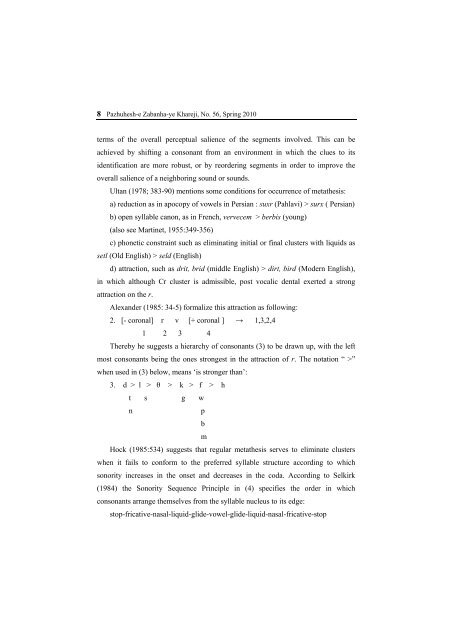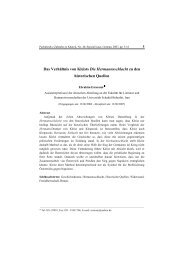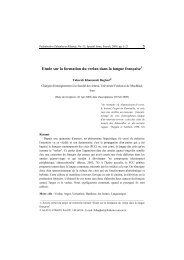Phonological Metathesis in Persian: Synchronic, Diachronic, and the ...
Phonological Metathesis in Persian: Synchronic, Diachronic, and the ...
Phonological Metathesis in Persian: Synchronic, Diachronic, and the ...
You also want an ePaper? Increase the reach of your titles
YUMPU automatically turns print PDFs into web optimized ePapers that Google loves.
8 Pazhuhesh-e Zabanha-ye Khareji, No. 56, Spr<strong>in</strong>g 2010<br />
terms of <strong>the</strong> overall perceptual salience of <strong>the</strong> segments <strong>in</strong>volved. This can be<br />
achieved by shift<strong>in</strong>g a consonant from an environment <strong>in</strong> which <strong>the</strong> clues to its<br />
identification are more robust, or by reorder<strong>in</strong>g segments <strong>in</strong> order to improve <strong>the</strong><br />
overall salience of a neighbor<strong>in</strong>g sound or sounds.<br />
Ultan (1978; 383-90) mentions some conditions for occurrence of meta<strong>the</strong>sis:<br />
a) reduction as <strong>in</strong> apocopy of vowels <strong>in</strong> <strong>Persian</strong> : suxr (Pahlavi) > surx ( <strong>Persian</strong>)<br />
b) open syllable canon, as <strong>in</strong> French, vervecem > berbis (young)<br />
(also see Mart<strong>in</strong>et, 1955:349-356)<br />
c) phonetic constra<strong>in</strong>t such as elim<strong>in</strong>at<strong>in</strong>g <strong>in</strong>itial or f<strong>in</strong>al clusters with liquids as<br />
setl (Old English) > seld (English)<br />
d) attraction, such as drit, brid (middle English) > dirt, bird (Modern English),<br />
<strong>in</strong> which although Cr cluster is admissible, post vocalic dental exerted a strong<br />
attraction on <strong>the</strong> r.<br />
Alex<strong>and</strong>er (1985: 34-5) formalize this attraction as follow<strong>in</strong>g:<br />
2. [- coronal] r v [+ coronal ] → 1,3,2,4<br />
1 2 3 4<br />
Thereby he suggests a hierarchy of consonants (3) to be drawn up, with <strong>the</strong> left<br />
most consonants be<strong>in</strong>g <strong>the</strong> ones strongest <strong>in</strong> <strong>the</strong> attraction of r. The notation “ >”<br />
when used <strong>in</strong> (3) below, means ‘is stronger than’:<br />
3. d > l > θ > k > f > h<br />
t s g w<br />
n<br />
p<br />
b<br />
m<br />
Hock (1985:534) suggests that regular meta<strong>the</strong>sis serves to elim<strong>in</strong>ate clusters<br />
when it fails to conform to <strong>the</strong> preferred syllable structure accord<strong>in</strong>g to which<br />
sonority <strong>in</strong>creases <strong>in</strong> <strong>the</strong> onset <strong>and</strong> decreases <strong>in</strong> <strong>the</strong> coda. Accord<strong>in</strong>g to Selkirk<br />
(1984) <strong>the</strong> Sonority Sequence Pr<strong>in</strong>ciple <strong>in</strong> (4) specifies <strong>the</strong> order <strong>in</strong> which<br />
consonants arrange <strong>the</strong>mselves from <strong>the</strong> syllable nucleus to its edge:<br />
stop-fricative-nasal-liquid-glide-vowel-glide-liquid-nasal-fricative-stop






